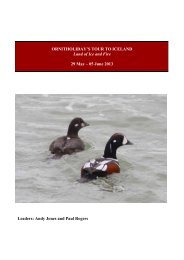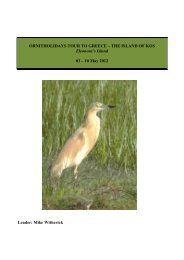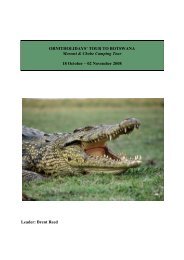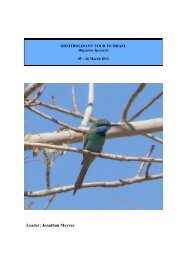Download 2014 Brochure (.pdf) - Ornitholidays
Download 2014 Brochure (.pdf) - Ornitholidays
Download 2014 Brochure (.pdf) - Ornitholidays
You also want an ePaper? Increase the reach of your titles
YUMPU automatically turns print PDFs into web optimized ePapers that Google loves.
Northern Bald Ibis<br />
M O R O C C O<br />
Outline Itinerary<br />
Day 1 Fly to Agadir<br />
Days 2-3 Agadir<br />
Day 4 Guelmim<br />
Days 5-7 Agadir<br />
Day 8 Depart Agadir<br />
Party Size<br />
Maximum of 12 clients.<br />
Accommodation<br />
Comfortable accommodation in twin-bedded<br />
and single rooms, with private facilities (the<br />
accommodation for our one night stay away<br />
from Agadir will be more basic but will still<br />
have private facilities).<br />
Transport<br />
By minibus or small coach.<br />
Cream-coloured Courser<br />
Sparrow in the village and perhaps Fulvous<br />
Babbler amongst the Prickly Pears. Nearby, we<br />
will look for Desert and Red-rumped Wheatears,<br />
whilst lark possibilities here include Thick-billed<br />
and Bar-tailed. We end the day exploring a rocky<br />
area for Desert Lark; with luck we will witness a<br />
fine sunset over the desert.<br />
Days 5 to 7<br />
We have an early breakfast before heading<br />
south-west of Guelmim along the Tan-Tan road<br />
which leads all the way to Mauritania. Whilst the<br />
most sought-after desert species can occur<br />
almost anywhere, we have a number of specific<br />
sites to visit and hope to find Cream-coloured<br />
Courser and Greater Hoopoe Lark in the sandier<br />
areas and Long-legged Buzzard, Lanner Falcon,<br />
Greater and Lesser Short-toed Larks in the<br />
cultivated plains. If we are lucky we may find<br />
Scrub and Spectacled Warblers in a roadside<br />
wadi and Temminck’s Lark in the stony desert.<br />
After a picnic lunch in a verdant oasis, where we<br />
may find Trumpeter Finch coming to drink, it will<br />
be time to reluctantly leave the desert and return<br />
to Agadir where we stay for the next three nights.<br />
The following day after a leisurely breakfast, we<br />
set off north-east along the mountain road<br />
towards Immouzzer. This road passes through<br />
some awe-inspiring scenery. We head first to the<br />
furthest spot, just over an hour from the coast,<br />
where in the bushes and pines we may be lucky<br />
and find Tristram’s Warbler in its breeding habitat<br />
as well as Crossbill (of the distinctive Atlas race)<br />
and Cirl Bunting. We drift back and have a tagine<br />
lunch in a restaurant with a panoramic view,<br />
before descending into the aptly named<br />
Paradise Valley, a truly beautiful spot. Here we<br />
can expect Eurasian Crag Martin and African<br />
Blue Tit. It is a wonderful spot for dragonflies<br />
including the exotic Ringed Cascader, Violet,<br />
Orange-winged and Red-veined Dropwings and<br />
Epaulet Skimmer. Spanish Terrapin and Barbary<br />
Ground Squirrel add to the variety on offer. We<br />
return to the hotel via a wonderfully positioned<br />
roadside shop in the hills selling plates and<br />
ammonites. Then, after a short break, in the late<br />
afternoon those who wish to continue birding will<br />
head to the fabulous Souss estuary with its large<br />
numbers of gulls, terns, waders and flamingos.<br />
There will be plenty for everyone to look at and<br />
we will patiently scan the flocks hoping in<br />
particular for Slender-billed and Mediterranean<br />
Gulls or a rare shorebird. The Moroccan race of<br />
Magpie is common in the eucalyptus trees.<br />
On our final full day we can either look again for<br />
Northern Bald Ibis or, if we have seen it already,<br />
head south towards Massa once more and, if so,<br />
our first destination is likely to be the area around<br />
Barrage Youssef-ben-Tachfine. Having turned off<br />
the main southbound road, we start scanning the<br />
fields by an irrigation channel and have a good<br />
chance of seeing Black-bellied Sandgrouse at<br />
close range, whilst Alpine Swift is a possibility. We<br />
then return to Massa and explore a different area<br />
to the south of the village where the long-billed<br />
race of Crested Lark is likely in the small fields; at<br />
the river itself we may find Bluethroat and the<br />
Spanish race of Yellow Wagtail, whilst Purple<br />
Heron and Little Bittern are both possibilities in<br />
the reeds. This area has often produced rarities<br />
on previous trips. During the afternoon, some will<br />
doubtless continue to scan for raptors, others for<br />
more dragonflies and butterflies. There may be<br />
time to briefly revisit the parts of the Massa<br />
estuary we have seen previously.<br />
Day 8<br />
If there is time, we shall take one last look at the<br />
Souss Estuary, just to see if there is anything new<br />
for us, before we catch the return flight to London.<br />
Includes<br />
All flights, meals, accommodation, transport,<br />
entry fees, services of the leaders, airport<br />
taxes and tips.<br />
Gradings<br />
Good/Basic<br />
140<br />
Warm/Hot<br />
Low<br />
Normal<br />
Relaxed<br />
Good<br />
Easy<br />
Scheduled<br />
Tristram’s Warbler<br />
To make a booking please call <strong>Ornitholidays</strong> on 01794 519445<br />
65








